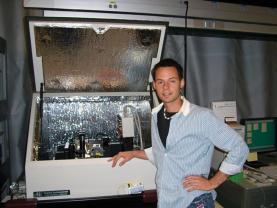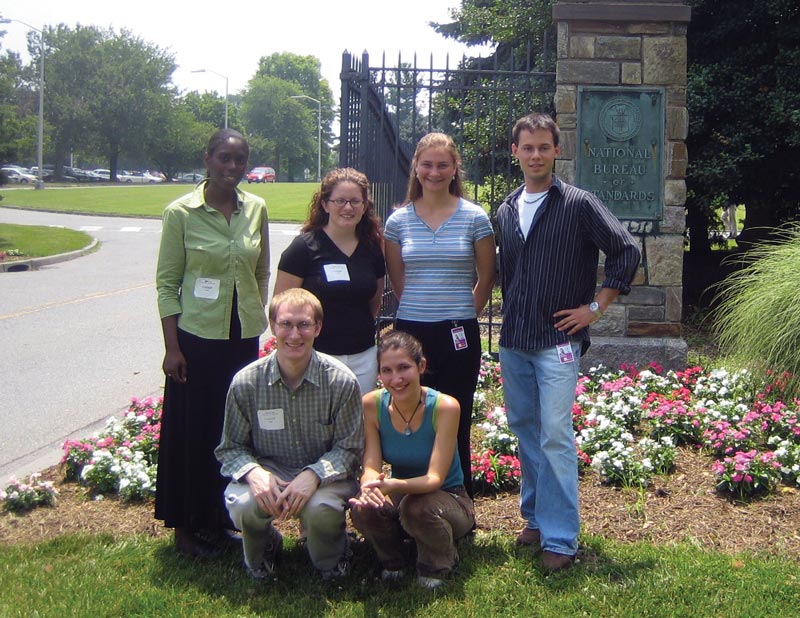Paper Trail
Fall
2013
Pathways - Advice from Experienced Voices
Paper Trail
How an Internship Can Shape Your Career
By:Bridger Anderson, 2005 SPS Intern
 In 2005 I was an SPS summer intern at the National Institute of Standards and Technology (NIST) in Gaithersburg, MD. Working with Ganesh Ramachandran, I used an atomic force microscope to make some measurements of molecules that self-assemble on gold. The experience was often challenging. It took some time to learn how to use the $150,000 machine without breaking its fine tip. On the nonwork side, the fire alarm kept going off in the building where I lived for the summer. These alarms, which caused the five-story dorm to be evacuated, were set off by individuals who executed at least two acts of poor judgment, pulling the alarm because of smoke from food burned in an oven and a microwave.
In 2005 I was an SPS summer intern at the National Institute of Standards and Technology (NIST) in Gaithersburg, MD. Working with Ganesh Ramachandran, I used an atomic force microscope to make some measurements of molecules that self-assemble on gold. The experience was often challenging. It took some time to learn how to use the $150,000 machine without breaking its fine tip. On the nonwork side, the fire alarm kept going off in the building where I lived for the summer. These alarms, which caused the five-story dorm to be evacuated, were set off by individuals who executed at least two acts of poor judgment, pulling the alarm because of smoke from food burned in an oven and a microwave.
But by the end of the summer, I had finally understood the techniques for obtaining good data and getting stable measurements, and I had taped a note next to the fire alarm: “Before you pull the fire alarm, get a second opinion.” My NIST supervisor wrote a paper about the research we did and gave me a copy. Though that paper was never published, it would prove to be a turning point for my career.
Immediately after my internship I started looking for a job. I was offered positions as a high school teacher, a construction worker, and a website designer. What I really wanted was to get a full-time position doing research before pursuing my education.
After about 6 months, I scored an interview at the Center for Nanoscale Science and Engineering (CNSE) at North Dakota State University in Fargo. I showed the interview committee the paper from NIST to demonstrate my interest and experience. My soon-to-be employer's exact words were, “I’m really glad you brought this in today. This is exactly the kind of thing we are doing.”
That paper helped me land my first permanent full-time position as a physicist. It changed my interviewer’s feelings about hiring me from iffy to definite. At CNSE, I participated in three different projects. All of those projects involved taking measurements just like those I had done at NIST. One project required an in-depth understanding of vacuum science, knowledge that has proven invaluable for my current position. Another was  presented at the American Physical Society meeting in Denver, CO, and was published before I applied to grad school.
presented at the American Physical Society meeting in Denver, CO, and was published before I applied to grad school.
That second paper helped me get into a few grad schools, including Arizona State University in Tempe, Ohio State University in Columbus, and Montana State University (MSU) in Bozeman. I was also diplomatically accepted to the University of Missouri, Kansas City (UMKC)—by which I mean I knew a guy from CNSE who was moving to UMKC and said he wanted me to be his student.
I chose MSU for mainly professional reasons. I really liked the program and wanted to work for one of the authors of the magnetism book sitting on my shelf at CNSE. (It was mere coincidence that the university was in the middle of the Bridger Mountain Range, near the Bridgerbowl Ski Lodge, with great hiking and camping.) I went on to get a master’s degree in physics and obtained a position as a process engineer at a micro-electro-mechanical systems (MEMS) foundry. I am currently a program manager and principal engineer on three development programs for Innovative Micro Technology in Santa Barbara, CA, and lead a group which has two full-time engineers and two full-time technicians. Recently our group received a high-level award for shattering the company record for wafer level packaging, which we did by reaching a far lower vacuum level than anyone ever had before in the company. Pulling that off took all of my SPS, CNSE, and MSU knowledge. I didn't think it was that big of a deal until I got named at a board meeting two months later for the achievement.
Internships are invaluable. They give undergraduates hands-on experiences that are not attainable in school. I found internships to be more closely geared toward real-world expectations than academia. Academia provides an environment where mistakes are acceptable and allowed to perpetuate for some time. Although mistakes do happen in industry as well, they need to be fixed very quickly. Otherwise, huge expenses result. I gained that type of understanding of immediacy from my SPS internship.
In my current job I am involved in making hiring decisions. I recently interviewed three candidates. When choosing between them, I looked for experiences similar to those offered by SPS internships. A candidate may have a BS or MS degree, but without that hands-on, real-world experience, I don’t really consider him or her for an engineering position. I may consider the candidate for a position as a technician, but that technician will then need to demonstrate that he or she is capable of performing as an engineer for about a year before actually advancing to an engineering position.
As an intern, I did not understand how important my two-month experience would ultimately be for my future. It not only landed me a job—and shaped how I hire others—but it also led me to my wife, whom I met in North Dakota while working at CNSE. //

NIST: The National Institute of Standards and Technology
From the smart electric power grid and electronic health records to atomic clocks, advanced nanomaterials, and computer chips, innumerable products and services rely in some way on technology, measurement, and standards provided by the National Institute of Standards and Technology.
Founded in 1901, NIST is a non-regulatory federal agency within the U.S. Department of Commerce. NIST's mission is to promote US innovation and industrial competitiveness by advancing measurement science, standards, and technology in ways that enhance economic security and improve our quality of life.
The agency operates in two locations: Gaithersburg, MD, and Boulder, CO. NIST employs about 3,000 scientists, engineers, technicians, and support and administrative personnel. NIST also hosts about 2,700 associates from academia, industry, and other government agencies, who collaborate with NIST staff and access user facilities. In addition, NIST partners more than 1,300 manufacturing specialists and staff at more than 400 MEP service locations around the country.
The Society of Physics Students has partnered with NIST to place SPS research interns in the Gaithersburg, MD, location every summer since 2002. //
